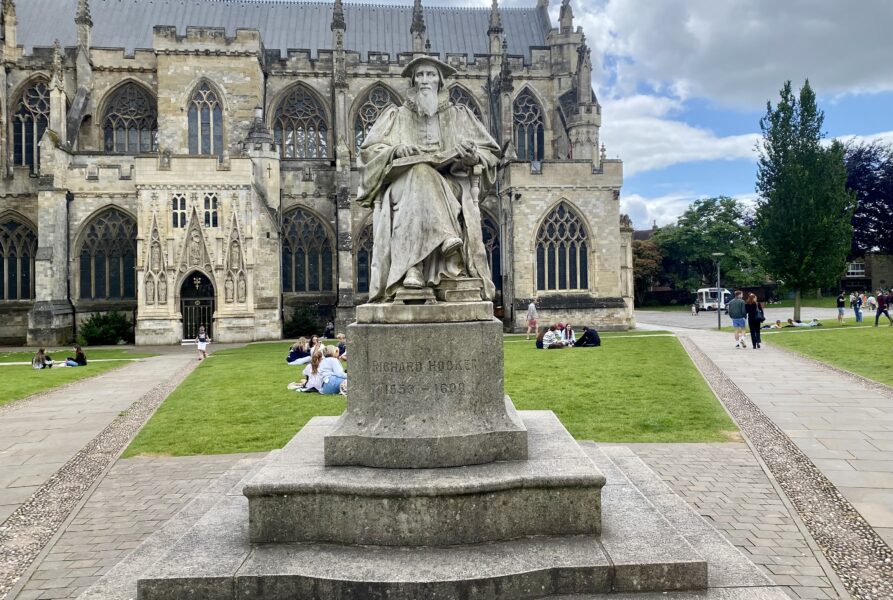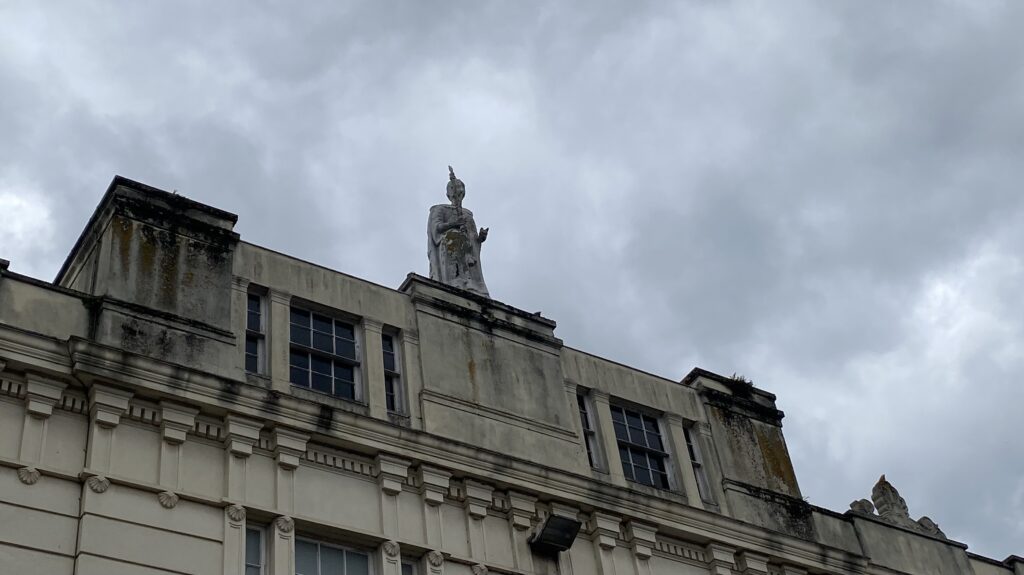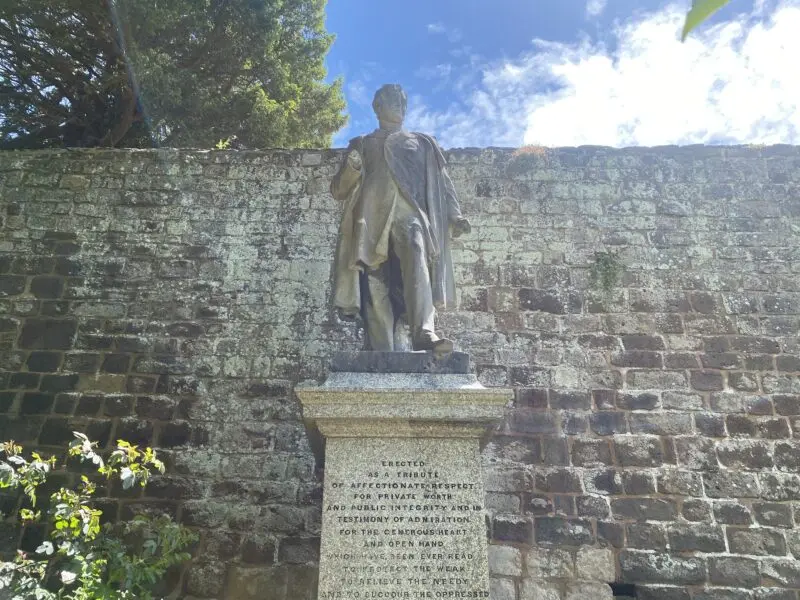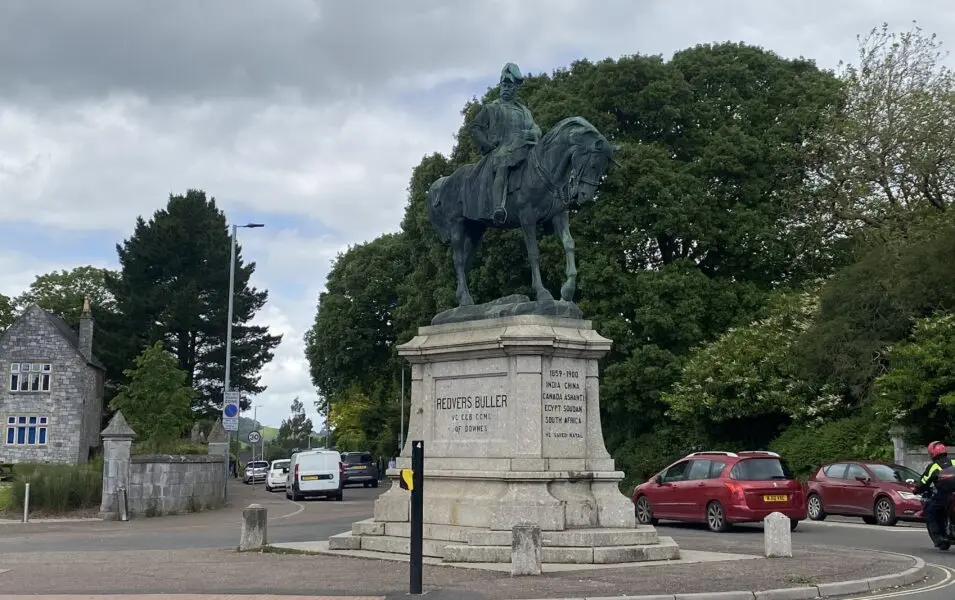
We pass them every day. These great imposing figures of stone, blankly watching on as the city ages around them. But who are they? And what stories do they tell?
Hope and Despair

It is easy to miss these two figures stationed high up above the shoppers of Princesshay, but they’ve been there for nearly seventy years.
Unveiled by the Mayor in June 1957, the figures commemorate the wartime bombing the city suffered at the hands of the Nazis. ‘Despair’, dressed in dishevelled clothing, covers her face at the horror of the violence while ‘Hope’, clean and smiling, looks on to a brighter future.
Richard Hooker

We’ve all seen this studious looking fellow when out enjoying the sun on Cathedral Green.
Richard Hooker was an influential 16th century preacher considered by many to be the Father of Anglicanism. Made from the same type of marble as the Parthenon, the statue of Hooker has sat by the cathedral since 1907.
Come October 2010, in a questionable financial decision given the economic state of the country at the time, £600,000 was spent moving Hooker 5 metres forward and relaying the footpaths so that onlookers could get right up to the statue without stepping on the grass. In practice, this largely means teenagers can sit on his base and vape without getting their trainers muddy.
Queen Victoria

If there is an afterlife, the late Queen Victoria is presumably irked that while Hooker gets to sit in front of the resplendent cathedral, the country’s second-longest reigning monarch is stuck up on the roof of M&S, covered in unwashed pigeon sh*t and overlooking Vodka Revolution and a Tesco Express.
In fact, the current statue isn’t even the original, because the 1848 version, made for Victoria’s 29th birthday, was made of timber, which had of course completely rotted by the time the building beneath was renovated in the 1970s. Hence, the current incarnation is actually built from fibreglass.
John Dinham

Created by the same sculptor that designed the nearby ‘Deer Stalker’ statue, Dinham has watched over Northernhay Gardens since July 1864.
Born poor, Dinham worked on Exeter High Street as a greengrocer for years, and was bankrupted in 1808 when his first marriage ended in disaster.
But after a few years of saving, he managed to purchase a tea importing company, and soon became a very wealthy man indeed. He spent the later years of his life giving back generously to the city that made him, and on his death left £21,000 to charity – the equivalent of over £1.2 million today. In a testament to his popularity, his statue was erected only a fortnight after his death.
William Reginald Courtenay

In 1942, frustrated at the destruction of German cities, Adolf Hitler decided that he wanted to destroy Britain’s quaintest tourist cities. He used a Baedeker travel guide (the German equivalent to Lonely Planet) to decide on Exeter as one of the cities he wanted to flatten. The resultant bombing raid destroyed much of the city – but this statue of the 11th Earl of Devon narrowly survived when a bomb exploded just a few metres away.
Courtenay, on the side of what was presumably a lucrative gig as an Abraham Lincoln lookalike, was a Tory MP at the time of the Corn Law debate, and was known locally as the ‘good Earl’ due to his charity work.
Thomas Dyke Acland

Unveiled in 1861, this statue of a long-serving Devonshire Conservative MP has had a difficult life. A gale in October 1877 took a finger, a tree fell on it in 1930 and knocked it of its pedestal, and by the turn of the century he had somehow lost his head. He may have had more work done on him than Simon Cowell, but he can still be found standing proudly at the edge of Northernhay Gardens.
General Buller

It is surprising that it has taken this long to reach a figure of controversy. Redvers Henry Buller was born to a prominent Devonshire family in 1839 and is commemorated due largely to his ‘heroic’ actions during the Zulu and Boer Wars. I include the scare quotes because, Buller’s legacy has been recently reassessed in the light of the Black Lives Matter movement.
Buller has sat atop his horse (named ‘Biffen’ for anyone wondering) since 1905, when 50,000 people contributed funds for the creation of his four and a half ton statue. But in 2020, the council initiated a review into its existence, due to allegations of war crimes in his military campaigns. Protestors hung signs on Buller – “Wanted! For War Crimes committed in China, Sudan and South Africa” and “Colonialism is nothing to be proud of.” The following year, it was decided that the statue would be allowed to remain. For those disappointed, spending eternity overlooking a roundabout two minutes down the road from a Wetherspoons seems like punishment enough.


